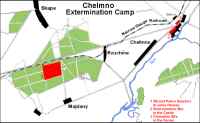 |
| Camp Map |
 |
| Chelmno 1941 * |
The deathcamp at Chelmno was established to kill the Jews of the
Warthegau (the annexed Polish province of
Poznan
and parts of the vojwodships
Bydgoszcz, Lodz, Pomorze and
Warsaw). In
1939 4,922,000 people lived in these
districts, among them 385,000 Jews.
Gauleiter Arthur Greiser declared the
Warthegau as the
"drilling ground" of National Socialism, where Nazi population policy would be undertaken. Poles, Jews and Roma
were classified as subhuman creatures. Discrimination against the Poles was followed by the persecution and eventual
extermination of Roma and Jews. Those who survived the initial excesses, were deported to forced labour camps and
ghettos, the largest of the latter being situated in
Lodz.
Gauleiter
Arthur Greiser ultimately received
Heinrich Himmler's agreement to kill all Jews who were incapable
of forced labour.
 |
| Chelmno SS Headquarters |
This first Nazi extermination camp was located in the small Polish village of Chelmno nad Nerem (German:
Kulmhof).
Chelmno is located 60 km northwest of
Lodz and 14 km southeast of
Kolo.
Kolo is located on the railway line
Lodz - Poznan. Already before WW2
Kolo and
Chelmno were connected by a narrow gauge railway, which ran from
Kolo to
Dabie.
The Nazis chose an empty manor house in Chelmno (called the
"Castle") for extermination purposes. Several other buildings of the former
estate were located within a 2.5-3 m high wooden fence and densely planted trees. The
granary is still visible today. For security reasons the main gate to
this site was constructed as a sluice: When the guards opened one gate, the other one was closed.
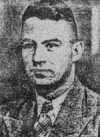 |
| Herbert Lange |
The camp was constructed in
November 1941, after the expulsion of nearly all inhabitants
from the area. The extermination of Romany and Jews was carried out by the so-called
Sonderkommando Kulmhof,
also known as Sonderkommando Lange. This special unit was named after its first commander
SS-Hauptsturmführer Herbert Lange. It was later called
Sonderkommando Bothmann, after
SS-Hauptsturmführer
Hans Bothmann,
Lange's successor.
Herbert Lange already had gained some experience in
killing mentally ill persons in Poland between
late 1939 and
June 1940 utilizing
gas vans. In Chelmno the Jews were destined to
perish in such gas vans.
In the early stages of activity, the
SS-Sonderkommando Lange was made up of about 15 members of the
Security Police, who occupied all of the important positions in the camp; and 50 - 60 police men of the
1. Kompanie des Polizeibataillons Litzmannstadt (Lodz) as well as
some police men of the 2. Company, divided into "Transport", "Castle" and "Forest Camp" details.
The regular police may have eventually numbered as many as 100. These
SS- and policemen also guarded the entire vicinity. According to witnesses
Artur Greiser and
Heinrich Himmler visited
Chelmno in its early stage.
All members of the
Sonderkommando received special pay. There is conflicting evidence
concerning the amounts involved.
Bruno Israel testified that he received
an additional 13 RM per day, paid directly by
Bothmann. The
former head of police at the camp,
Alois Häfele, stated that ordinary
policemen received an extra salary of 12 RM per day, the NCOs 15 RM. The wife of
Josef Peham, a police NCO, reported that the supplement varied
from 10 - 13 RM per day. Whatever the precise figure, the
Sonderkommando's" total salary, including
the bonus, more than doubled their basic pay.
In early
March 1943, at the end of Chelmno's first phase,
Greiser arrived together with some members of the NSDAP. At the
"
Riga Inn" in
Kolo
(German:
Warthbrücken) a party was organized, and each member
of the
Sonderkommando got 500 RM from
Greiser (for one time only),
combined with the promise that each of them can spend two holiday weeks at his private estate in
Berlin.
The party bill was sent to
the NSDAP
Gauleitung Wartheland.
Directly subordinate to the
Kommando were group of former prisoners (mainly from Fort VII in
Poznan) who had
been selected during the euthanasia actions. They worked mainly, but not exclusively, in the forest camp. These men
received many privileges, particularly after they had completed their day's work, and in effect were not treated as
prisoners
(
see a letter!). Those comprising this special unit were
Franciszek Piekarski, Henryk Mania, Kajetan Skrzypczynski, Lech Jaskolski, Stanislaw
Polubinski, Henryk Maliczak, Stanislaw Szymanski and
Marian Libelt.
They worked in Chelmno in the first stage of the camp's existence, up to the time of the arrival of
Bothmann.
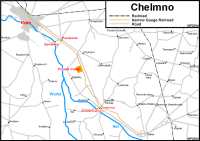 |
| Survey Map |
Most of the Jews were brought by train (1,000 persons usually, in 20 - 22 wagons) to
Kolo station. Until
mid-March 1942
each incoming transport was locked in the
Kolo synagogue until lorries were available to ferry the people to
Chelmno. Because the German administrative authorities complained about this method of imprisoning the Jews in the
town centre, the procedure was changed from
mid-March. From that time
onwards, the Jews had to
change trains at Kolo station, and board narrow gauge railway wagons, which
carried them 6 km to
Powiercie village. There the
train stopped, and the victims were ordered to march 1.5 km through a forest to
Zawadka village where they were locked in the
mill for their last night. The next
morning they were brought by lorries to Chelmno. Some other transports were taken by lorries directly to Chelmno where
they spent the night before being gassed. According to witnesses
Christian
Wirth visited the location in
spring 1942.
In the second phase of Chelmno (
1944) the victims were transported
by the narrow gauge railway directly from
Kolo to Chelmno because the railway track has been repaired (the wooden bridge
over the tributary of the Warta River between
Powiercie and Chelmno had been
destroyed by Polish troops during their retreat in
1939).
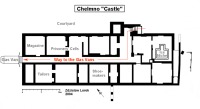 |
| The "Castle" |
In Chelmno itself, the people arrived at the
Schlosslager (Castle Camp). In the first phase the incoming
Jews were addressed by camp commander
Bothmann, his substitute
SS-Untersturmführer Albert Plate,
Polizei-Meister
Willy Lenz,
Polizei-Meister Alois
Haeberle or
Franciszek Piekarski, also member of the "Sonderkommando".
He was disguised as the squire of the estate: feather hat, nice dress, jack-boots, smoking his pipe...
They told the Jews that some of them will go to work to Austria or further eastward, others will work at his estate.
They would be fairly treated and receive good food. For sanitary reasons they had to take a shower first, and their
clothes had to be disinfected. After this reassuring speech the Jews were led to the undressing room in the first
floor. There the Jews had to
undress and hand over their valuables.
During Chelmno's second phase an SS man welcomed the Jews in possibly the same way.
Those valuables not embezzled by SS men were sent to
Pabianice near
Lodz, together with the victims' clothing.
There the
Lodz ghetto administration had set up some warehouses for the
collecting and sorting of the loot. The spoils (e.g.
furs) were first examined and then
transferred to Germany or sold to Germans who lived in the
Warthegau. On
9 September 1944 for example, 775 wristwatches
and 550 pocket watches were sent from Chelmno
to the
Lodz ghetto administration. Much
clothing was stained with dirt and blood. Some still had the Jewish
stars attached. Many people in Germany must surely therefore have been aware of the fate of the Jews.
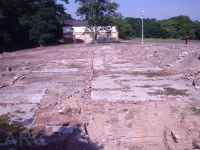 |
Foundations of the Manor House
in 2004 |
After undressing, the people were brought downstairs again, to a corridor whose walls carried signs such as,
"to the bath" and "to the doctor". There the SS told the Jews that they had to enter a lorry which would take them
to the baths. Pieces of
soap were given to the people. Three Poles, who were probably
sentenced to death,
hit the Jews with whips if they did not get into the gas van fast enough. The victims finally entered the gas van by
passing up an enclosed wooden ramp which was placed in exact alignment with the door through which the Jews had
to leave the building. The SS quickly closed the airtight doors of the van and the driver
(
Walter Burmeister among others / "The Good Old Days" - E. Klee, W. Dreeßen, V. Riess,
The Free Press, NY, 1988., p. 219-220) switched on the motor,
but allowed the vehicle to remain stationary. While the gas van was waiting for a new batch of victims, the driver
connected the van's exhaust to the loading space (gas chamber) with a tube, so that the exhaust fumes could be
discharged into the loading space. After 5-10 minutes of horrible screaming, all of the people in the loading
compartment had been suffocated. In Chelmno one large gas van (probably
Magirus, for 150 victims)
and two smaller ones
(
Opel Blitz and Diamond
Reo, for 80 - 100 victims) were used. According to the witness
Bruno Israel a fourth van was used for disinfection of clothing.
The
Sonderkommando may have used special petrol, mixed with poison. The van's engines were driven by petrol and
not diesel.
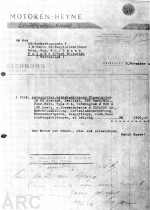 |
| Invoice |
After the gassing the lorry
was driven to the
Waldlager (Forest Camp) in the
Rzuchowski Forest, about 4 km (2 1/2 miles) away. On the way to
the
Waldlager one day the back doors opened suddenly and some corpses fell out. Since that day this
corner was called
"
Corner of Death". At the
Waldlager the corpses
were unloaded by the Jewish
Waldkommando (Forest Command) prisoners. 10 minutes were allowed
for evaporation of the exhaust fumes, then the loading space had to be emptied. The
Waldkommando had
to search the bodies for jewellery and gold teeth, which were extracted.Although an unknown number
of Jews managed to escape from the
Waldkommando, there were only three who survived to the end
of the war to provide personal evidence concerning the manner in which the camp functioned:
Mordechai Podchlebnik from the camp's first period,
Mordechai Zurawski, and
Simon Srebnik
from the second one. The first escapee from the
Waldkommando to provide evidence of conditions in the camp was
Szlamek Bajler (also known as
Yakov Grojanowski),
who recounted his experiences to
Emanuel Ringelblum in the
Warsaw Ghetto.
Until
spring of 1942, the bodies had been buried in four long
mass graves. From that time onwards the corpses were cremated. Two
crematoria were built, which were probably complemented by two
mobile field ovens. The latter were possibly installed to test their
efficiency. It was at Chelmno that
Paul Blobel first experimented with various
methods of disposing of corpses, before perfecting the system used at other extermination sites in the East,
including those of
Aktion Reinhard. Despite all efforts remnants of
human bones are still visible.
The members of the
Waldkommando were killed after a short time and replaced by new arrivals. After the war,
inhabitants of nearby villages confirmed that smoke rose constantly from the vicinity.
Adolf Eichmann and
Rudolf Höß
visited Chelmno in
autumn 1942.
In
May 1960 Eichmann testified during a (the?) first
interrogation (following his capture) by the Israeli police captain
Avner W. Less:
"
Eichmann: I only know the following, that I have
seen the following:
A room, if I remember exactly, perhaps five times as big as this one here, or it could have been four times larger.
Jews were in it who were ordered to undress, and then a van drove up which was completely sealed; at the front
(of the room) the doors were opened and the van drove up to a kind of ramp so to say. And there the Jews had to
then get in. Then the van was closed and drove off.
Less: How many people did the van hold?
Eichmann: I don't know exactly. I was not even able to observe it. I didn’t
look into it the whole time. I couldn't do it, couldn't, I had enough of that. The screaming, and, and, I was
too excited here and so on. I also told that to Müller during my report.
He didn't profit very much from my report. I then followed the van – carefully, with one of the people there who knew
the way; and there I saw the most horrible sight I had seen in all my life until then. The van drove up to a lengthy pit,
the doors were opened and corpses thrown out, the limbs so flexible, as if they were still alive. Were thrown into
the pit; I still see a civilian there pulling out teeth with pliers; and then I beat it. Entered the car, and beat it, and
didn't say any word anymore... I was fed up. I just remember that a doctor there, in a white coat, told me to look
through a peephole when they were in the van. I refused. I couldn't, I couldn't say another word, I had to leave.
Then I arrived in Berlin and reported to Gruppenführer
Müller. I told him exactly the same as now, I couldn't tell him more...
`Terrible,’ I say, `that inferno, can't, it is, I can't do this,’ I said."
Rudolf Höß about his visit in Chelmno, on
16 September 1942:
"
During my visit in Kulmhof I saw the
extermination installations with the gas vans which were prepared for killing by exhaust fumes.
The chief of the command there described this method as very unreliable because the gas was
produced very irregularly, and often was not enough for killing."
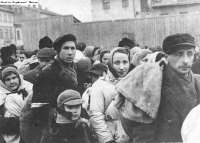 |
| Zychlin Deportation * |
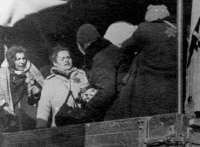 |
| Wloclawek Deportation * |
Chelmno's first phase lasted from
7 December 1941, until
March 1943. The first
victims were deported from nearby places:
Babiak, Dabie, Deby Szlacheckie, Grodziec,
Izbica Kujawska, Klodawa, Kolo, Kowale Panskie, Nowiny Brdowskie and
Sompolno. In
mid-January the SS
started to exterminate the Jews of the
ghetto in
Lodz:
Between 16 and 29 January 1942
10,003 Jews were killed, from
22 February - 2 April 34,073, from
4-15 May 11,680 and from
5-12 September 1942 15,859. Apart from Jews from the
Lodz Ghetto, nearly all the other Jews of the
Warthegau had been killed
by
early 1943. Also among the victims were 15,000 Jews from Germany, Austria,
Czechoslovakia and Luxemburg, 5,000 Romany, several hundred Poles and an unknown number of Soviet POWs, as well
as 88 Czech children from
Lidice.
On
7 April 1943 the SS blew up the manor house and the two furnaces.
On this day a last unexpected transport arrived,
with Jews who suffered from typhus. The Germans were afraid of being infected, and ordered them to go to
the first storey of the palace building.
Dynamite was placed in the basement and the building was blown up, together with the Jews.
Then
Bothmann and his
Sonderkommando were ordered to Italy / Yugoslavia
to combat partisans (
SS-Division "Prinz Eugen"). An important find is a
beer bottle of the
Dreher Brewery in
Trieste, which was excavated at the rear of the
chelmno palace in archealogical digs. It is a proof that at least one member of
Bothmann's staff has been in
Trieste, perhaps
San Sabba. In addition a few
other bottles were found there.
 |
| Telex from Greiser to Himmler |
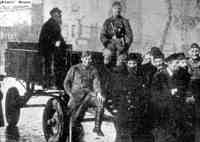 |
| Sieradz Deportation * |
During Chelmno's second phase, in
June and July 1944, a further 10,000 Jews from the
Lodz Ghetto were murdered.
Himmler and
Greiser had decided on the
ghetto's liquidation. For that purpose the
Sonderkommando Bothmann was ordered back, the
Waldlager
was reactivated and two new crematoria were built at the
Waldlager.
Now the Jews from
Lodz were transported usually by train to
Kolo (sometimes by lorries directly to Chelmno). From
Kolo by the narrow gauge railroad to Chelmno village. There
they spent the night in the
church. The next day they had to wait on the place in front of the church
from were they were carried by lorries to the
Waldlager in groups of mainly 150.
At the
Waldlager the people were separated into two large
barracks, each about 20 x 10 m. Each barrack had two rooms, one for men, the other for women and children.
Arrival at these two structures was a ruse to keep the intended victims from panicking. Both huts had a wooden fence
extending on either side in order to make it appear as though the Jews had arrived at a transit or work camp. Each
structure was falsely numbered and in addition signs were painted on them: - on the outside: "To the Bath", inside
the barracks: "To the Doctor, Barrack Number…" etc. The SS kept this pretence of "resettlement" up until the last
minute as the victims undressed, first the women and children followed by the men. When naked they filed through the
door marked "
Zum Bad" ("To the bath"). Behind this door a passageway 20 - 25 m long by 1.5 m
wide, also enclosed by wooden boarding, turned sharply at its end to finish up on a ramp. From there
the Jews climbed into the waiting gas vans. This method had been adopted, tried and tested at the death camps of
Belzec and
Sobibor. It was finally perfected
in
Treblinka. A simple, smaller version, copied from the
Aktion
Reinhard camps, was easily implemented at Chelmno.
It has to be added here that the enclosed camouflaged fences, adopted in the
Aktion Reinhard camps, were far
from "perfect" until the final "tube" (German:
Schlauch) in
Treblinka was
established. The original "tube"
(named
Die Schleuse - English: "Sluice") in the
Belzec extermination camp
from
July 1942 - December 1942 was
straight in appearance; a "mistake", corrected at
Sobibor by a "blind corner".
Even so, the
Sobibor Schleuse was
far too long; therefore the
Treblinka "Road to Heaven" (so-called in the
Aktion Reinhard Camps) was curved, but neither too long nor too short for its murderous task.
The survivors
Zurawski and
Srebrnik,
and the captured gendarme
Bruno Israel, described the cremation facilities
as follows:
"
They were built deep in the ground and did not project above its surface. They were shaped like
inverted cones with rectangular bases. At the top at ground level the furnaces measured 6x10 m (2Ox33 ft.)
and they were 4 m (13 ft.) deep. At the bottom, by the ash-pit, they measured 1.5x2 m (5x6 ft.). The grates
were made of
rails. A channel to the ash-pit ensured the
admittance of air and permitted
the removal of ashes and bones. The sides of the furnace were made of
firebrick and faced with cement. In the furnace
were alternate layers of chopped wood and corpses: to facilitate combustion, space was left between the corpses. The
furnace could hold 100 corpses at a time, but as they burned down, fresh ones were added from above. The ashes and
remains of bones were removed from the ash-pit, ground in mortars, and, at first, thrown into especially dug ditches;
but later, from 1943 onwards, bones and ashes were secretly
carted to Zawadka at night, and there
thrown into the river."
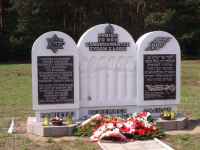 |
Lodz Monument at the
Rzuchowski Forest |
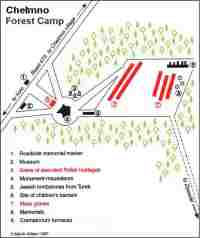 |
Map of the Memorial
at Rzuchowski Forest |
In order to speed up the liquidation of the
Lodz ghetto the remaining 70,000
Jews there were deported to Auschwitz.
In
September 1944 the crematoria in the
Waldlager were dismantled.
The
Sonderkommando and the
Waldkommando was still there and buried corpses in mass graves.
All installations were destroyed in
mid-December 1944 but
Bothmann and his men still waited for orders.
New orders never arrived and
Bothmann decided to dissolve the
Sonderkommando Kulmhof and wanted to execute the rest of the
Waldkommando. Then the
Jews which were locked in the granary, revolted. Two Nazis were shot, and two prisoners
(
Srebrnik and
Zurawski) escaped.
The remaining Jews were executed and the granary was set on fire.
The site was abandoned on
17 January 1945 due to the proximity of
the advancing Red Army.
At least 152,000 people perished in Chelmno. All witnesses confirm that as a rule, about 1,000 Jews were brought
to Chelmno each day, excluding the victims who arrived in lorries from the surrounding vicinity.
See our lists
Young Children Victims of Chelmno
and
Deportation Transports.
A private
memorial stone has been erected at the former
Schlosslager in Chelmno, donated by a German relative of a victim. Another memorial stone is at
Kolo station, a third one in
Powiercie,
another one at the former
Waldlager.
See the names of 7,168 individuals from
Lodz who were transferred to the
death camp at Chelmno,
between June and August 1944 at
"Lodz Transports to the Chelmno Extermination Camp".
Trials:
Greifswald (DDR), 1951 and Güstrow (DDR), 1952:
El., Karl - 14 years
(Police Schupo Lodz)
Transport of about 30,000 Jewish men, women and children from the Lodz ghetto to KZ Chelmno, and participation in
the loading of victims onto lorries in which they were killed by exhaust fumes. (...) May 1941 – February 1942.
Hannover, 1963 – 1964:
Bradfisch, Otto - 13 years
Fuchs, Günter - life sentence
(Polizei Gestapo Lodz)
Participation in the killing of the Jews from Lodz by the head of the Gestapo office Lodz and the head of department
IIB. Deportation of many thousands of Jews from the Lodz ghetto to the Chelmno annihilation camp. Mishandling, in
part with fatal consequences, and individual shootings of numerous Jews during the deportations. Shooting of Jews
still found in the ghetto at the time of its liquidation in August. From 1944. From January 1942 till May 1942,
in September 1942 and from June 1944 till August 1944.
Bonn, 1963 – 1965:
B., Heinrich Walter - no punishment imposed (par.47 MStGB - military penal code)
Burmeister, Walter - 13 years
Häfele, Alois - 13 years
Heinl, Karl - 7 years
H., Wilhelm - 13½ months
Laabs, Gustav - 13 years
M., Friedrich - 13½ months
Me., Anton - no punishment imposed (par.47 MStGB - military penal code)
Möbius, Kurt - 8 years
Sch., Wilhelm - 13½ months
S., Alexander - no punishment imposed (par.47 MStGB - military penal code)
(Haftstättenpersonal KL Chelmno)
Killing of altogether at least 150,000 Jewish (German, French, Austrian, Polish, Czech) men, women and children, as
well as of about 5,000 Gypsies, who were deported in the course of a number of 'resettlement operations' from the Lodz
ghetto and its immediate surroundings, to Chelmno, where they were exterminated in 'gas vans'. From December 1941
till March 1943 and June 1944 till August 1944.
Kiel, 1965:
F., Gustav Wilhelm - 13½ months
(Haftstättenpersonal KL Chelmno)
Killing of, altogether, at least, 145,000 Jewish (German, French, Austrian, Polish, Czech) men, women and children,
who were deported, in several 'resettlement operations', from the ghetto of Lodz and its immediate surroundings to KL
Chelmno and exterminated in 'gas vans'. From March 1942 till March 1943.
Photos:
GFH
*
Archiwum GK Komise
*
Yad Vashem
*
Arie A. Galles
*: Part of his art suite "Fourteen Stations/Hey Yud Dalet",
exhibited at the Morris Museum in Morristown, New Jersey.
See the artist's website:
http://fermi.phys.ualberta.ca/~amk/galles/index.html
Sources:
Gutman, Israel, ed.
Encyclopedia of the Holocaust, Macmillan Publishing Company, New York, 1990
Kogon, Eugen; Langbein, Hermann; Rückerl, Adalbert; eds.
Nazi Mass Murder, Yale University Press, New Haven
and London, 1993
DDR-Justiz, NS-Verbrechen Vol. IV, XIX, XXI, XXII
Bednarz, Wladyslaw.
Oboz stracen w Chelmnie nad Nerem , Warszawa, 1946
Gulczynski, Janusz.
Oboz smierci w Chelmnie nad Nerem, Konin, 1991
Dreßen, Willi; Klee, Ernst; Riess, Volker; eds.
The Good Old Days, The Free Press, NY, 1988
www.shtetlinks.jewishgen.org/belchatow/
© ARC (http://www.deathcamps.org) 2005


























